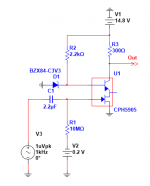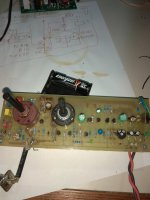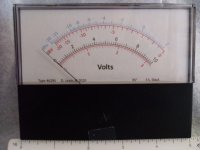> You must load a CFB opamp........
AHHH! I missed that the plan cuts to unity gain by opening the bottom of the NFB loop (with relay contact). That makes things much more complicated. Rf has to be much higher to maintain stability. Good eye.
I think of Rg through Rf as one load.
Back to topic: Here's an idea to eliminate the TL071 and replace with an extremely simple BJT/JFET combination transistor -- the CPH5905 -- a $0.57 part with a 1dB noise figure (the TL071 is 18nV/RtHz @1kHz). No feedback, so no negative impedance wonkiness. CPH5905 is in production, unlike the BF862 which is EOL.
You should get around 20dB gain -- and it's good to 1MHz. V2 and R3 can be adjusted to get ~2.5Vds.
While the CPH5905 is surface mount, I place them on a 6-pin adapter.
Attachments
Looking at available poly-switch the primary objection is the fact that they are smd which is something I am trying to avoid.
This one is an Elektor publish.
Two scales.
100μV-20V
600μV-60V
Bandwidth up to about 2Mhz.
Two scales.
100μV-20V
600μV-60V
Bandwidth up to about 2Mhz.
Attachments
Last edited:
That is an unusual range selection. Any more info on the source of the project?
Analog audio millivoltmeter

It came with a 90 degree scale (0-50 uA). The meter can go to a 100 degree sweep but it requires the removal of the zero adjuster which does not seem like a good idea so a compromise of 95 degrees was used.
To determine the linearity of the meter a current was applied (at 5 volts) that produced 100% deflection and the the voltage was reduced in 1 volt increments to verify the linearity. The results:
5 Volts, 100%, 51.4uA
4 Volts, 80%, 40.8uA
3 Volts, 60%, 30.5uA
2 Volts, 40%, 20.3uA
1 Volt, 21%, 10.2uA
The linearity is very good through most of the range and it degrades in the lower 30% of movement which is to be expected. All in all this looks suitable for the project.


